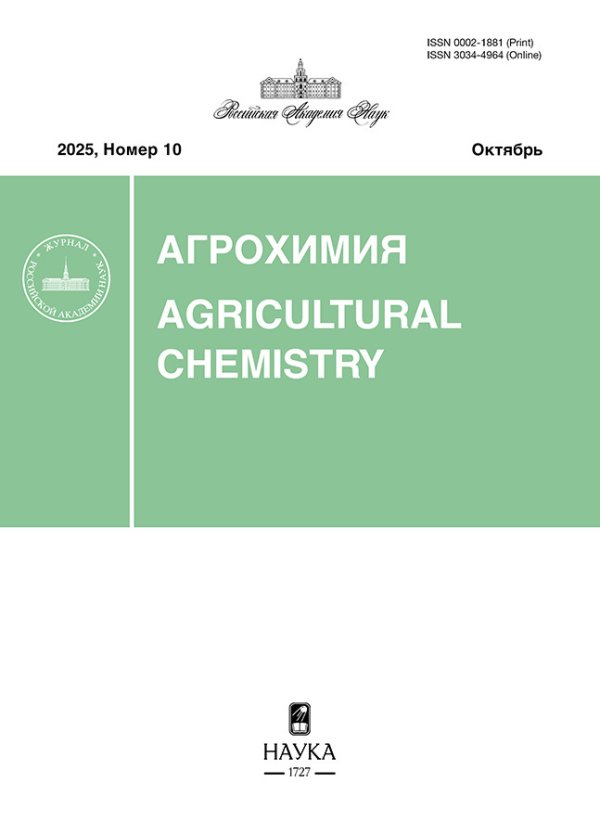Phosphate regime and phosphatase activity of degraded soils of agricultural lands of the Donetsk People’s Republic
- Authors: Syshchykov D.V.1, Berezovskiy А.S.1, Agurova I.V.1
-
Affiliations:
- Donetsk botanical garden
- Issue: No 2 (2025)
- Pages: 10-15
- Section: Soil Fertility
- URL: https://rjsvd.com/0002-1881/article/view/684890
- DOI: https://doi.org/10.31857/S0002188125020025
- EDN: https://elibrary.ru/vbvwkr
- ID: 684890
Cite item
Abstract
The phosphate regime and the degree of availability of soils of agricultural lands with mobile phosphates were studied, and the phosphatase activity of the surveyed soils was determined as a diagnostic sign of the content of mobile phosphorus in the soil. The study was carried out on model sites of varying degrees of degradation located in the southern part of the Shakhtersky district of the DPR. A decrease in the content of mobile phosphorus was found in all model plots in comparison with the indicators of zonal soil. The most negative trend associated with a decrease in the content of this element relative to the control was noted in the arable horizon of plots 2, 7 (by 45.8–47.2%), which was due to the significant removal of mineral nutrition elements by crops forming a significant phytomass, such as Helianthus annuus L., Zea mays L. In the soils of sites 2 and 4, the maximum phosphatase activity was recorded, amounting to 210–346% relative to the indicators of the zonal soil, which was due to a lack of exchangeable phosphorus in the soil and additional release of enzymes by microorganisms and plants. The soils of most model sites 2, 4, 6, 7 were characterized by a “high” level of phosphatase activity, for sites 3 and 5, activity indicators were estimated as “average”. For all studied model sites, data were obtained showing a decrease in the content of mobile phosphorus and phosphatase activity with the depth of the soil profile.
Keywords
Full Text
About the authors
D. V. Syshchykov
Donetsk botanical garden
Author for correspondence.
Email: 2007dmitry@rambler.ru
Russian Federation, psosp. Il'icha 110, Donetsk 283023, DPR
А. S. Berezovskiy
Donetsk botanical garden
Email: 2007dmitry@rambler.ru
Russian Federation, psosp. Il'icha 110, Donetsk 283023, DPR
I. V. Agurova
Donetsk botanical garden
Email: 2007dmitry@rambler.ru
Russian Federation, psosp. Il'icha 110, Donetsk 283023, DPR
References
- Сушеница Б.А. Состояние проблемы фосфора в земледелии // Плодородие. 2006. № 2. С. 11–13.
- Гинзбург К.Е. Фосфор основных типов почв СССР. М.: Наука, 1981. 235 с.
- Иванов А.Л., Сычев В.Г., Державин Л.М., Адрианов С.Н., Бражникова Н.В., Карпова Д.В., Карпухин А.И., Кирпичников Н.А., Колончук В.Д., Самойлов Л.Н. Агробиогеохимический цикл фосфора. М.: РАСХН, 2012. 513 с.
- Nosko B.S. The formation of the agrogenic typical chernozem profile in the Ukrainian forest-steppe after plowing virgin steppe and fallow soils // Euras. Soil Sci. 2013. V. 46. № 3. Р. 325–336. doi: 10.1134/S1064229313030058
- Чекмарев П.А., Лукин С.В. Мониторинг содержания подвижных форм фосфора и калия в пахотных почвах Белгородской области // Достиж. науки и техн. АПК. 2020. Т. 34. № 2. С. 5–9. doi: 10.24411/0235-2451-2020-10201
- Стекольников К.Е., Комова А.В. Фосфатазная активность чернозема выщелоченного и режим фосфатов в стационарном опыте // Изв. Оренбург. ГАУ. 2017. № 3(65). С. 183–188.
- Наими О.И. Влияние гуминового препарата на динамику азота и фосфора в почве при внесении соломы // Мат-лы Международ. научн. экол. конф. “Экологические проблемы развития агроландшафтов и способы повышения их продуктивности”. Краснодар: КубГАУ, 2018. С. 173–175.
- Наими О.И., Куцерубова О.Ю. Динамика подвижного фосфора в черноземе обыкновенном карбонатном при запашке соломы // Вестн. ДонГАУ. 2018. № 3-1(29). С. 69–75.
- Звягинцев Д.Г., Добровольская Т.Г., Бабьева И.П., Зенова Г.М., Лысак Г.В., Марфенина О.Е. Роль микроорганизмов в биогеоценотических функциях почв // Почвоведение. 1992. № 6. С. 63–77.
- Купревич В.Ф., Щербакова Т.А. Почвенная энзимология. Минск: Наука и техника, 1966. 274 с.
- Котелев В.В. Роль микроорганизмов в разложении фосфатов и передвижении фосфора в почве: Автореф. дис. ... д-ра биол. наук. М.: Институт микробиологии АН СССР, 1964. 26 с.
- Наими О.И., Куцерубова О.Ю. Влияние антропогенных факторов на ферментативную активность чернозема обыкновенного // Пути повыш. эффект-ти орош. землед-я. 2015. № 2(58). С. 58–62.
- Наими О.И., Безуглова О.С., Полиенко Е.А., Лыхман В.А., Горовцов А.В., Поволоцкая Ю.С., Дубинина М.Н., Патрикеев Е.С. Фосфатный режим и активность фосфатазы в черноземе обыкновенном при возделывании нута // Агрохим. вестн. 2020. № 3. С. 25–29. doi: 10.24411/1029-2551-2020-10034
- Русакова И.В. Ресурсосберегающие технологии использования растительных остатков // Агрохим. вестн. 2012. № 3. С. 40–42.
- Методические рекомендации по морфологическому описанию почв / сост. Дюкарев А.Г., Пологова Н.Н., Герасько Л.И. Томск: Изд-во СО РАН, 1999. 39 с.
- Розанов Б.Г. Морфология почв. М.: Изд-во МГУ, 1983. 320 с.
- Методы почвенной микробиологии и биохимии / Под ред. Звягинцева Д.Г. М.: Изд-во МГУ, 1991. 304 с.
- Практикум по агрохимии / Под ред. Минеева В.Г. М.: Изд-во МГУ, 2001. 689 с.
- Казеев К.Ш., Колесников С.И., Вальков В.Ф. Биологическая диагностика и индикация почв: методология и методы исследований. Ростов/нД.: Изд-во РГУ, 2003. 216 с.
- Доспехов Б.А. Методика полевого опыта (с основами статистической обработки результатов исследований). М.: Агропромиздат, 1985. 351 с.
- Наими О.И., Дубинина М.Н., Матюгин В.А., Лыхман В.А. Динамика ферментативной активности чернозема обыкновенного под посевами подсолнечника // Вестн. ДонГАУ. 2023. № 1(47). С. 53–61.
- Хазиев Ф.Х. Системно-экологический анализ ферментативной активности почв. М.: Наука, 1982. 203 с.
- Пилецкая О.А., Прокопчук В.Ф. Фосфатный режим и фосфатазная активность черноземовидной почвы // Вестн. КрасГАУ. 2014. № 8(95). С. 47–50.
- Турусов В.И., Гармашов В.М., Дьячкова Т.И. Ферментативная активность чернозема обыкновенного в различных севооборотах при разных способах обработки почвы // Агрохимия. 2012. № 9. С. 21–25.
Supplementary files











